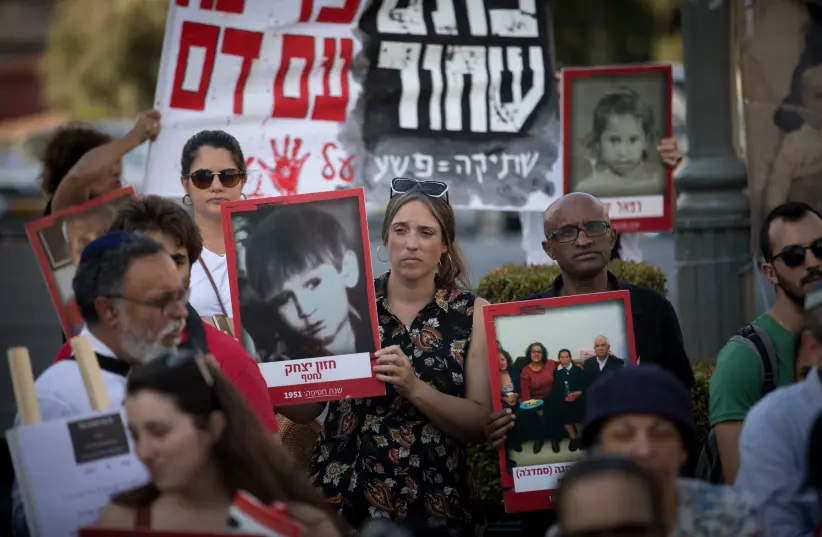Uriel Khoury, whose family immigrated from Tunisia in 1948, disappeared about 69 years ago.
The grave of the child Uziel Khoury, who is suspected of being one of the lost children of Yemen, the Balkans and the Middle East was opened on Monday after a five-year legal battle, and after a court rejected the state’s claims that the opening of the tomb should be postponed for another month due to soil moisture, and ordered the tomb to be opened on a pre-determined date.
The purpose of opening the tomb is to allow the remains of the body to be exhumed for identification, including taking a DNA sample to perform a family relationship test with the family at the Institute of Forensic Medicine at Abu Kabir.
ADVERTISING

The baby whose grave will be opened is Khoury, whose family immigrated from Tunisia in 1948. In 1952, Uziel and his brother were born, and when he was about a year old, Uziel fell ill, was taken by welfare services, transferred to a hospital and soon after, the family received word that he had passed away. He is buried in the Segula Cemetery in Petah Tikva.
‘They said they’d bring him back’
Khoury’s sister, Chaya Mazuz, described her brother’s disappearance to KAN on Monday, saying that her father had brought him for treatment before he disappeared.
“They said a month or two and they’d bring him back,” said Mazuz. “A day before they were with him, the next day they called ‘he died.’ How could it be? It wasn’t even 24 hours.”
“They won’t find anything here. If they do, it’s not him,” added Mazuz, stressing that the state had given them “four or five versions” of how Uziel had died.
“One time they said it was because he fell from their hands. Another time they said he had a heart attack and died. Another time they said he had a fever of 104 F (40 C). Every time they said something different,” said Uziel’s sister. “We didn’t know anything. My father was a simple man. From where would he know what they’re saying? They didn’t even show him. From a distance, they showed him some package. He wanted to come to bury him in Haifa. We’re from Haifa. Why did they bring him here? They said, there’s no need. We’ll bury him, we’ll do everything. Go home.”
Health Ministry: We’re opening the grave to remove concerns
The Health Ministry stated that it was doing this “out of a desire to investigate the truth and remove the families’ concerns about the identity of their loved ones. The Health Ministry supported the enactment of the law at the time and undertook to be trusted and responsible for the implementation of this law.”
“It’s been 69 years since he disappeared,” said Khoury’s sister Mazal Berko on Monday, according to KAN. “We’re already four years in a battle in the courts. I really want to believe that the state, since it made this decision, will really tell us the truth. We’re not asking for anything from the state. Just the truth.”
Last week it was reported that some 65 years after evidence of the disappearance of Yemeni and Balkan children began to pile up, the grave of one of the children suspected of having been disappeared would be opened for the first time, and the body would be brought for investigation at the Abu Kabir Institute of Forensic Medicine. The decision came after a petition by five families to the court to open the tomb.
Following the petition, the judges sought the state’s response. The state gave its consent on the condition that the investigation be conducted at the Institute of Forensic Medicine in Abu Kabir, so that it will be conducted in an orderly manner and not privately. The families agreed, provided that during the interrogation, there would also be an interrogator on their behalf.
Over the years, three commissions of inquiry have been established to examine the affair. The committees found that out of 1,053 cases that examined 979 children who died, 69 were defined as “unknown” – cases in which no evidence was found about the children’s current location, and five were identified as adopted.
At the end of 2016, the State Archives published hundreds of thousands of documents dealing with the affair, including the investigation materials from the committees. The site has uploaded files containing 210,000 documents, in which you can browse and see what happened to the children, such as the cause of death and where they were buried. According to the findings, there is no evidence of institutionalized abduction of Yemeni, Middle Eastern and Balkan children.
About a year ago, the previous government, about a month before the election, approved a draft resolution to provide compensation to families affected by the affair. The approved outline regulated monetary compensation for the affected families in the amount of NIS 162 million.
NIS 150,000 will be transferred to family members who were not notified of their child’s death in real time, including the circumstances of the death, an undiscovered burial site or whose burial site was found with considerable delay. In the event that the last committee’s conclusion was that it is not known what happened to the child, his family members will receive compensation amounting to NIS 200,000.

